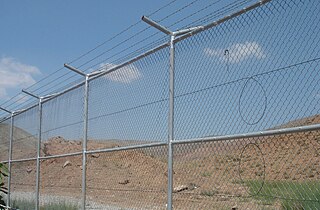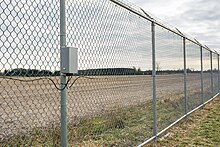
Physical security describes security measures that are designed to deny unauthorized access to facilities, equipment, and resources and to protect personnel and property from damage or harm. Physical security involves the use of multiple layers of interdependent systems that can include CCTV surveillance, security guards, protective barriers, locks, access control, perimeter intrusion detection, deterrent systems, fire protection, and other systems designed to protect persons and property.
An intrusion detection system is a device or software application that monitors a network or systems for malicious activity or policy violations. Any intrusion activity or violation is typically reported either to an administrator or collected centrally using a security information and event management (SIEM) system. A SIEM system combines outputs from multiple sources and uses alarm filtering techniques to distinguish malicious activity from false alarms.

A security alarm is a system designed to detect intrusions, such as unauthorized entry, into a building or other areas, such as a home or school. Security alarms protect against burglary (theft) or property damage, as well as against intruders. Examples include personal systems, neighborhood security alerts, car alarms, and prisons.

An electric fence is a barrier that uses electric shocks to deter people and/or other animals from crossing a boundary. The voltage of the shock may have effects ranging from discomfort to death. Most electric fences are used for agricultural fencing and other forms of non-human animal control, although they are also used to protect high-security areas such as military installations or prisons, where potentially-lethal voltages may be used. Virtual electric fences for livestock using GPS technology have also been developed.

A passive infrared sensor is an electronic sensor that measures infrared (IR) light radiating from objects in its field of view. They are most often used in PIR-based motion detectors. PIR sensors are commonly used in security alarms and automatic lighting applications.

A motion detector is an electrical device that utilizes a sensor to detect nearby motion. Such a device is often integrated as a component of a system that automatically performs a task or alerts a user of motion in an area. They form a vital component of security, automated lighting control, home control, energy efficiency, and other useful systems.

Home security includes both the security hardware placed on a property and individuals' personal security practices. Security hardware includes doors, locks, alarm systems, lighting, motion detectors, and security camera systems. Personal security involves practices like ensuring doors are locked, alarms are activated, owning a Dog, windows are closed, and extra keys are not hidden outside.

A prison escape is the act of an inmate leaving prison through unofficial or illegal ways. Normally, when this occurs, an effort is made on the part of authorities to recapture them and return them to their original detainers. Escaping from prison is also a criminal offense in some countries, such as the United States and Canada, and it is highly likely to result in time being added to the inmate's sentence, as well as the inmate being placed under increased security that is most likely a maximum security prison or supermax prison. In Germany, and a number of other countries, it is considered human nature to want to escape from a prison and it is considered as a violation of the right of freedom, so escape is not penalized in itself.
A red team is a group that pretends to be an enemy, attempts a physical or digital intrusion against an organization at the direction of that organization, then reports back so that the organization can improve their defenses. Red teams work for the organization or are hired by the organization. Their work is legal, but can surprise some employees who may not know that red teaming is occurring, or who may be deceived by the red team. Some definitions of red team are broader, and include any group within an organization that is directed to think outside the box and look at alternative scenarios that are considered less plausible. This can be an important defense against false assumptions and groupthink. The term red teaming originated in the 1960s in the United States.
Infrastructure security is the security provided to protect infrastructure, especially critical infrastructure, such as airports, highways rail transport, hospitals, bridges, transport hubs, network communications, media, the electricity grid, dams, power plants, seaports, oil refineries, liquefied natural gas terminals and water systems. Infrastructure security seeks to limit vulnerability of these structures and systems to sabotage, terrorism, and contamination.

The Tactical Automated Security System (TASS) is a U.S. Air Force intrusion detection and surveillance system used for security monitoring around fixed site airbases, semi-permanent Forward Operating Bases (FOBs), and other mobile tactical deployments.

Demarcation of a perimeter, when the protection of assets, personnel or buildings is required, is normally affected by the building of a perimeter fence system. The level of protection offered varies according to the threat level to the perimeter. Different types of perimeter fencing include:
A gas detector is a device that detects the presence of gases in an area, often as part of a safety system. A gas detector can sound an alarm to operators in the area where the leak is occurring, giving them the opportunity to leave. This type of device is important because there are many gases that can be harmful to organic life, such as humans or animals.
Diver detection sonar (DDS) systems are sonar and acoustic location systems employed underwater for the detection of divers and submerged swimmer delivery vehicles (SDVs). The purpose of this type of sonar system is to provide detection, tracking and classification information on underwater threats that could endanger property and lives. Further, this information is useful only to the extent that it is made available to authorities in time to make possible the desired response to the threat, be it deterrent or defensive action. Subsurface threats are a difficult problem, because reliable detection is available to date chiefly by use of high-resolution active sonar or trained dolphins or sea lions. The threat of an underwater terrorist attack is a concern to the maritime industry and port law enforcement agencies. Ports face a range of threats from swimmers, boat-delivered ordnance such as limpet mines and other forms of improvised underwater explosive devices. DDS systems have been developed to provide underwater security for ports, coastal facilities, offshore installations, pipelines and ships. Due to the variety of life and objects that exist under the water, it is desirable that a DDS system be capable of distinguishing between large sea mammals, shoals of fish; a ship's wake; a diver with an open circuit scuba set and a stealth diver with a rebreather. DDS systems have been developed that can be mounted on the seabed, on a pier or on the hull of a vessel. For complete port security these systems are integrated with the surface surveillance and security systems employed at ports, coastal facilities and offshore installations. Various systems provide specialized features to facilitate their use in port security systems including automatic detection features.

The Unattended Ground Sensor (UGS) are a variety of small sensors, generally covert, dedicated to detect and identify activities on the ground such as enemy soldiers or vehicles. UGS come as systems with an integrated communication network and processing capabilities.

Future Fibre Technologies (FFT) is a fiber optic sensing technologies company based in Melbourne, Australia, with its US head office in Mountain View, California, Middle East head office in Dubai, Indian head office in New Delhi and European head office in London. Founded in 1994, Future Fibre Technologies product line provides optical fiber intrusion detection systems for perimeters, buried oil and gas pipelines and data communication networks.
A driveway alarm is a device that is designed to detect people or vehicles entering a property via the driveway. A driveway alarm system is often integrated as a component of a system which automatically performs a task or alerts home owners of an unexpected intruder or visitor. Driveway alarms can be a vital component of security, automated lighting control, home control, energy efficiency, and other useful systems.

Artificial intelligence for video surveillance utilizes computer software programs that analyze the audio and images from video surveillance cameras in order to recognize humans, vehicles, objects, attributes, and events. Security contractors program the software to define restricted areas within the camera's view and program for times of day for the property being protected by the camera surveillance. The artificial intelligence ("A.I.") sends an alert if it detects a trespasser breaking the "rule" set that no person is allowed in that area during that time of day.
Perimeter security refers to natural barriers or built fortifications to either keep intruders out or to keep captives contained within the area the boundary surrounds.
Senstar Corporation develops and manufactures perimeter intrusion detection systems, video management software, security lighting, personal duress systems, and access control software for the physical security and video surveillance industries. Its headquarters are located in Ottawa, Ontario. Senstar products protect facilities around the world, including critical infrastructure sites, military bases, nuclear power plants, airports, personal estates, borders, and correctional facilities.












